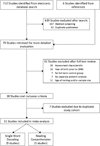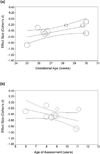Reading abilities in school-aged preterm children: a review and meta-analysis
- PMID: 25516105
- PMCID: PMC4397135
- DOI: 10.1111/dmcn.12652
Reading abilities in school-aged preterm children: a review and meta-analysis
Abstract
Aim: Children born preterm (at ≤32wks) are at risk of developing deficits in reading ability. This meta-analysis aims to determine whether or not school-aged preterm children perform worse than those born at term in single-word reading (decoding) and reading comprehension.
Method: Electronic databases were searched for studies published between 2000 and 2013, which assessed decoding or reading comprehension performance in English-speaking preterm and term-born children aged between 6 years and 13 years, and born after 1990. Standardized mean differences in decoding and reading comprehension scores were calculated.
Results: Nine studies were suitable for analysis of decoding, and five for analysis of reading comprehension. Random-effects meta-analyses showed that children born preterm had significantly lower scores (reported as Cohen's d values [d] with 95% confidence intervals [CIs]) than those born at term for decoding (d=-0.42, 95% CI -0.57 to -0.27, p<0.001) and reading comprehension (d=-0.57, 95% CI -0.68 to -0.46, p<0.001). Meta-regressions showed that lower gestational age was associated with larger differences in decoding (Q[1]=5.92, p=0.02) and reading comprehension (Q[1]=4.69, p=0.03) between preterm and term groups. Differences between groups increased with age for reading comprehension (Q[1]=5.10, p=0.02) and, although not significant, there was also a trend for increased group differences for decoding (Q[1]=3.44, p=0.06).
Interpretation: Preterm children perform worse than peers born at term on decoding and reading comprehension. These findings suggest that preterm children should receive more ongoing monitoring for reading difficulties throughout their education.
© 2014 Mac Keith Press.
Conflict of interest statement
The authors state that they have no interests that might be perceived as posing a conflict or bias.
Figures




Comment in
-
Gestational age and learning disabilities.Dev Med Child Neurol. 2015 May;57(5):401. doi: 10.1111/dmcn.12681. Epub 2015 Jan 13. Dev Med Child Neurol. 2015. PMID: 25582224 No abstract available.
Similar articles
-
Academic Outcomes of School-Aged Children Born Preterm: A Systematic Review and Meta-analysis.JAMA Netw Open. 2020 Apr 1;3(4):e202027. doi: 10.1001/jamanetworkopen.2020.2027. JAMA Netw Open. 2020. PMID: 32242904 Free PMC article.
-
Academic trajectories of very preterm born children at school age.Arch Dis Child Fetal Neonatal Ed. 2019 Jul;104(4):F419-F423. doi: 10.1136/archdischild-2018-315028. Epub 2018 Sep 27. Arch Dis Child Fetal Neonatal Ed. 2019. PMID: 30262464
-
Finnish children born very preterm have good reading comprehension but weak reading fluency at age 11 years - a longitudinal cohort study.Child Neuropsychol. 2025 May;31(4):585-612. doi: 10.1080/09297049.2024.2415531. Epub 2024 Oct 14. Child Neuropsychol. 2025. PMID: 39401072
-
Reading abilities in preterm children: a systematic review and meta-analysis.Cogn Process. 2024 Nov;25(4):545-565. doi: 10.1007/s10339-024-01192-2. Epub 2024 May 16. Cogn Process. 2024. PMID: 38753253
-
Using Eye Movements to Assess Language Comprehension in Toddlers Born Preterm and Full Term.J Pediatr. 2017 Jan;180:124-129. doi: 10.1016/j.jpeds.2016.10.004. Epub 2016 Nov 3. J Pediatr. 2017. PMID: 27816220 Free PMC article.
Cited by
-
Associations between Language at 2 Years and Literacy Skills at 7 Years in Preterm Children Born at Very Early Gestational Age and/or with Very Low Birth Weight.Children (Basel). 2021 Jun 16;8(6):510. doi: 10.3390/children8060510. Children (Basel). 2021. PMID: 34208622 Free PMC article.
-
Association of Neonatal Midazolam Exposure With Hippocampal Growth and Working Memory Performance in Children Born Preterm.Neurology. 2023 Nov 7;101(19):e1863-e1872. doi: 10.1212/WNL.0000000000207817. Epub 2023 Sep 25. Neurology. 2023. PMID: 37748888 Free PMC article.
-
Effects of size at birth on health, growth and developmental outcomes in children up to age 18: an umbrella review.Arch Dis Child. 2023 Dec;108(12):956-969. doi: 10.1136/archdischild-2022-324884. Epub 2023 Jun 20. Arch Dis Child. 2023. PMID: 37339859 Free PMC article.
-
Executive Functions and Reading Skills in Low-Risk Preterm Children.Children (Basel). 2025 Jul 31;12(8):1011. doi: 10.3390/children12081011. Children (Basel). 2025. PMID: 40868463 Free PMC article.
-
Neurobehavioral Phenotype and Dysexecutive Syndrome of Preterm Children: Comorbidity or Trigger? An Update.Children (Basel). 2022 Feb 11;9(2):239. doi: 10.3390/children9020239. Children (Basel). 2022. PMID: 35204960 Free PMC article. Review.
References
-
- Blencowe H, Cousens S, Oestergaard MZ, et al. National, regional, and worldwide estimates of preterm birth rates in the year 2010 with time trends since 1990 for selected countries: a systematic analysis and implications. Lancet. 2012;379:2162–2172. - PubMed
-
- Baron IS, Rey-Casserly C. Extremely preterm birth outcome: a review of four decades of cognitive research. Neuropsychol Rev. 2010;20:430–452. - PubMed
-
- Roberts D, Dalziel S. Antenatal corticosteroids for accelerating fetal lung maturation for women at risk of preterm birth. Cochrane Database Syst Rev. 2006;3:CD004454. - PubMed
-
- Bland RD. Neonatal chronic lung disease in the post-surfactant era. Biol Neonate. 2005;88:181–191. - PubMed
-
- Doyle LW, Anderson PJ. Pulmonary and neurologic follow-up of extremely preterm infants. Neonatology. 2010;97:388–394. - PubMed
Publication types
MeSH terms
Grants and funding
LinkOut - more resources
Full Text Sources
Other Literature Sources
Medical

